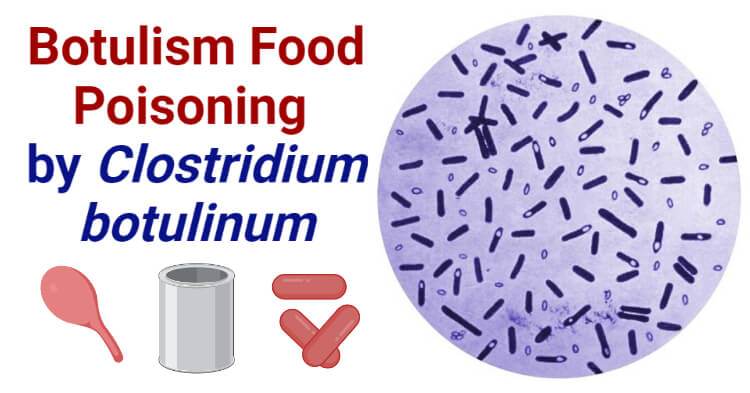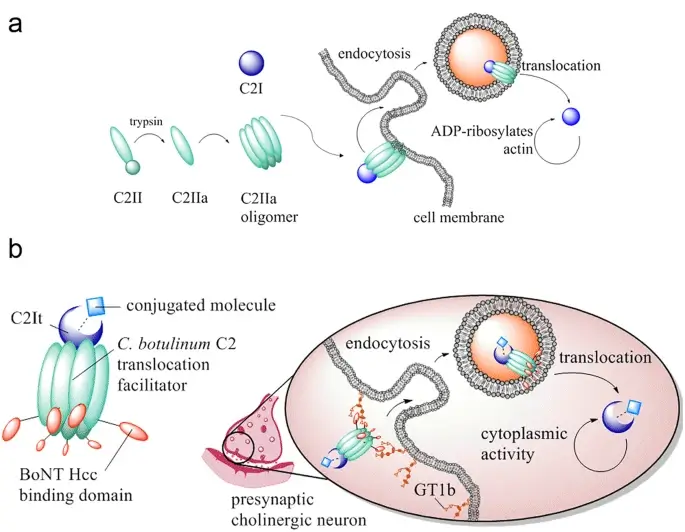Interesting Science Videos
What is Botulism Food Poisoning?
Botulism is a life-threatening food-borne disease that causes neuroparalysis from the consumption of botulinum neurotoxins (BoNTs). Botulism is a rare disease but has a high fatality rate even a small amount of toxin can kill millions.
- Clostridium botulinum causes intoxication i.e, disease occurs either from ingesting preformed BoNTs in foods or production of BoNTs in the intestine.
- There are seven distinct botulinum toxins (Type A to G) that cause disease in humans and animals.
- The clinical-epidemiological forms of botulism are food-borne botulism, infant botulism and wound botulism.
- Botulinum toxins Type A, B and E are associated with food-borne botulism in humans.
- The lethal dose of BoNTs for humans is 0.2µg to 2µg per kg body weight.
- Botulinum toxin is considered a hazardous biological substance in the environment.

Source of Clostridium botulinum contamination
- C. botulinum is anaerobic, spore former, gram-positive bacterium and its spores are widely distributed in the environment from the soil to sewage, mud, lakes, sediments of sea and oceans and are also found in the intestine of land and aquatic animals.
- Due to the nature of the bacterium to grow in wide distribution, its spore can contaminate foods where it colonizes and produces toxins.
- C. botulinum spores contaminating honey and syrup which are the major source of infant botulism.
- Poorly processed canned foods are also the main source of contamination as the spores can tolerate high heating temperatures during processing.
- Other food sources include various types of lake and sea fishes, smoked, salt-dried and fermented meat products.
- Type A and B BoTNs are also commonly present in soil and biofertilizers, therefore, they are likely to contaminate vegetables and fruits.
- Improperly cooked vegetable products such as beans, baked potatoes, corn, celery, mushrooms, onions and olives.
Clostridium botulinum neurotoxin production
- The BoNTs are extracellular proteins produced by C. botulinum that weighs around 150kDa.
- Based on the physiology and phylogenetic of bacteria, BoNTs have seven distinct serotypes from Type A to H.
- All seven toxins are categorized into four groups based on proteolytic and non-proteolytic activity: Group I, II, III and IV.
- Group I proteolytic Type A, B and F can proliferate on temperature range from 10 to 20°C similarly Group II non-proteolytic Type B, E and F at 2.5 to 3°C.
- Group III includes non-proteolytic Type C and D while Group IV has Type G.
- C. botulinum is strict anaerobes and can resist high temperatures where they form spores and when consumed produce toxins in the intestine and cause intoxication.

Clinical manifestation of Botulism Food Poisoning
- Symptoms are visible within 18 to 38 hours of ingestion that affect the gastrointestinal tract at an initial stage.
- Common symptoms include abdominal pain, nausea, vomiting, diarrhea and sometimes constipation.
- After the intoxication, neurological symptoms appear that include flaccid paralysis, symmetric descending weakness, slurred speech, difficulty in swallowing, dizziness, blurred vision, dry mouth and extraocular muscle weakness.
- In infant botulism, babies under 1 year are mostly affected being a poorly developed gut microflora where the toxins are formed in the intestine.
- In infants, symptoms like a weak hoarse cry, ptosis, poor suck, inability to hold the head upright and weak muscles may appear.
- In the case of wound botulism, the organism colonizes in the infected part like wound, abscess, pus where the Clostridium spores germinate and produce toxins.
- The symptoms of wound botulism are hypotension, respiratory problems, eye muscle paralysis, ataxia and dilated fixed pupils.
- Death usually occurs within 3 to 6 days of intoxication in case of fatality.
Epidemiology of Botulism Food Poisoning
- Botulinum toxin was used as a biological agent during World War II by the British, American and Japanese military.
- The large outbreak till reported was in Egypt in 1991 by the consumption of Type E toxin present in a traditionally salted fish dish known as fesaikh which resulted in 91 cases of an outbreak with 18 death.
- The fish was salted and was stored in the barrels which created a suitable environment for the growth of botulinum toxin.
- Recently in 2004, an osteopathic physician used botulinum toxin which he attempted to use it on his own and his girlfriend as a botox. Later, both were hospitalized suffering from respiratory failure and were on ventilation for several months.
- About 90% of the botulinum cases occur in the United States reporting 9 to 10 outbreaks each year.
- Home-preserved food products were associated with those outbreaks mainly canning, bottling and preserving food products in oil.
Botulinum toxin action
- The orally ingested botulinum toxin or toxin that are produced in-situ must resist stomach acid then only can pass through the intestine where it gets absorbed and colonizes in the duodenum and jejunum.
- Then the toxin passes into the bloodstream taken up by endocytosis and reaches the peripheral nervous system.
- Once it gets inside the neuron, its chain gets cleaved where it acts as a zinc-dependent protease and attacks SNARE proteins (soluble N-ethylmaleimide sensitive fusion protein attachment receptor).
- It binds at the ending point of the nerve-muscle junction and prevents the release of acetylcholine then the transmission of stimuli stops hence results in flaccid paralysis.
Detection methods of Botulism Food Poisoning
1. Bioassay
- The bioassay using a mouse is the most sensitive and widely used technique by injecting the toxin and determining its toxicity.
- Mice develop symptoms within 4 hours of injection.
- Vibration of the abdomen, wasp-shaped abdomen, paralysis of limbs and difficulty in breathing are the characteristic symptoms of the botulinum toxin.
2. Immunoassay
- The most sensitive immunoassays used to determine the botulinum toxin is ELISA.
- ELISA is binds the antigen (toxin) to the antibody (antitoxin) present in the solid surface.
- Then another enzyme-labeled antibody binds to the antigen and the amount of toxin can be determined by an enzymatic reaction.
- The specificity and sensitivity of ELISA are determined by the quality of the anti-serum used.
3. Endopeptidase assay
- Endopeptidase assay is an in-vitro assay to determine the potency of the toxin for therapeutic uses. (Eg: Botox, Dysport, Xeomin).
- It is measured by a bioluminescent signal, fluorescence resonance energy transfer (FRET) and mass spectrometry.
- Endopeptidase assay is more reliable than immunoassays as it detects only active botulinum toxins.
4. PCR-based assays
- A conventional multiplex PCR detects the specific toxin gene using high annealing temperature primer on agarose gel electrophoresis. It can detect toxins Type A, B, E and F.
- Real-time PCR detects BoNT A, B and E.
- Fluorescence-based PCR amplifies gene fragments and detects the toxin at high sensitivity within 1 to 2 hours.
Treatments of Botulism Food Poisoning
- A person showing similar symptoms of botulism should be placed immediately in intensive care with a parenteral nutritional supply.
- If the toxin is suspected, antitoxin should be taken within 24 hours for effectiveness as it neutralizes all the free toxins in the bloodstream before reaching the neuromuscular junction.
- Currently available antitoxins are Bi-(AB) or trivalent (ABE) equine immunoglobulins.
- In the case of wound botulism, the wound should be treated with antibiotics such as penicillins.
Control measures of Botulism Food Poisoning
- Proper heat treatment (above 121°C) and refrigeration (below 4°C) of foods.
- Acidifying agents such as citric acid reduces the chance of spore formation in canned products.
- Avoid food that you suspect is undercooked or not well reheated.
References
- Pavlik, B., Hruska, E., Van Cott, K. et al. Retargeting the Clostridium botulinum C2 toxin to the neuronal cytosol. Sci Rep 6, 23707 (2016). https://doi.org/10.1038/srep23707.
- Notermans, S. H. W., Stam, C. N., & Behar, A. E. (2014). CLOSTRIDIUM | Detection of Neurotoxins of Clostridium botulinum. Encyclopedia of Food Microbiology, 481–484
- Aureli, P. (2017). Botulism. International Encyclopedia of Public Health, 254–262.
- McLauchlin, J., & Grant, K. A. (n.d.). Clostridium botulinum and Clostridium perfringens. Foodborne Diseases, 41–78.
- Austin, J. W. (2016). Clostridium: Occurrence and Detection of Clostridium botulinum and Botulinum Neurotoxin. Encyclopedia of Food and Health, 155–159.
- Lebeda, F. J., Dembek, Z. F., & Adler, M. (2018). Foodborne Botulism From a Systems Biology Perspective. Foodborne Diseases, 275–308.
- Horowitz, B. Z. (2005). Botulinum Toxin. Critical Care Clinics, 21(4), 825–839.
